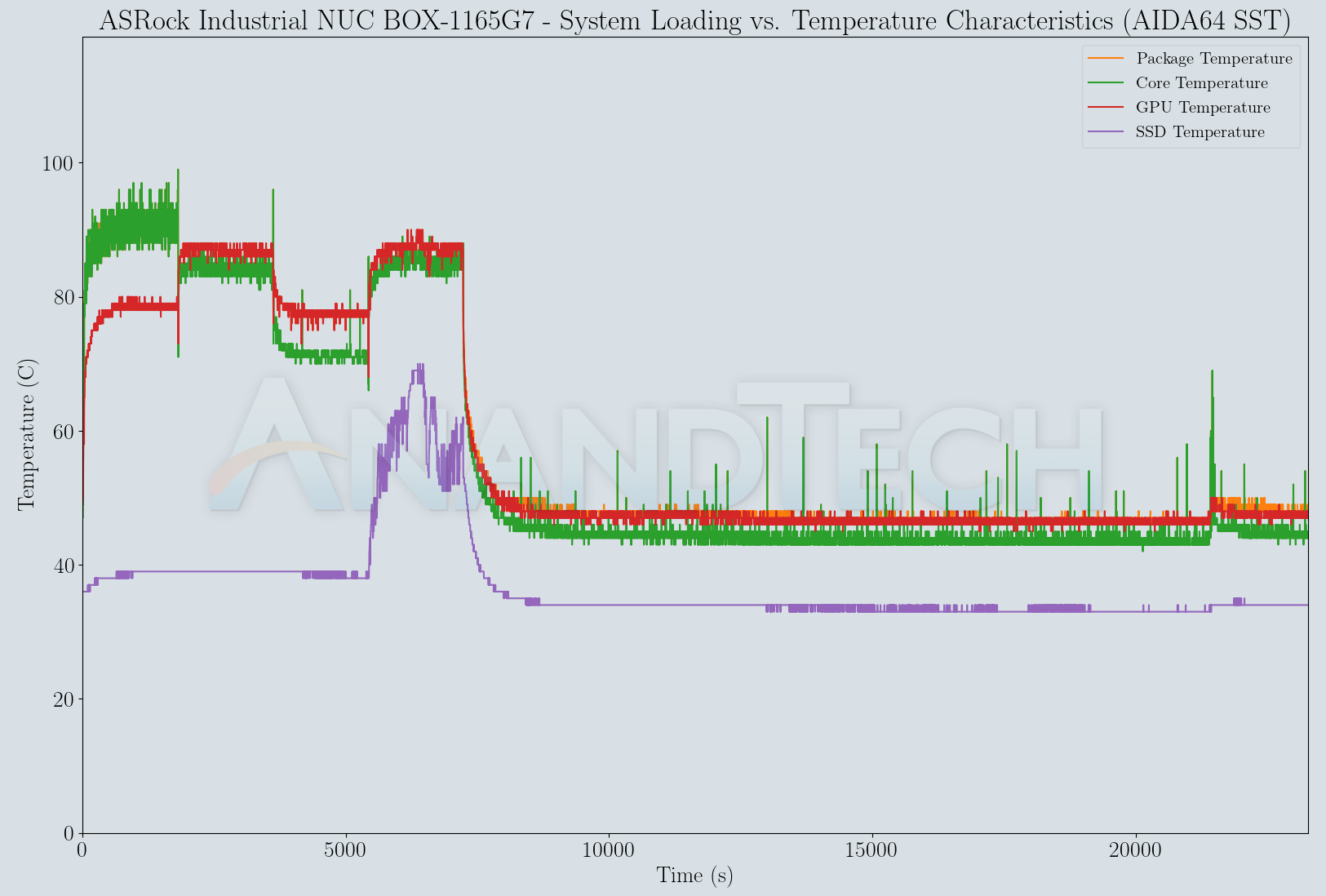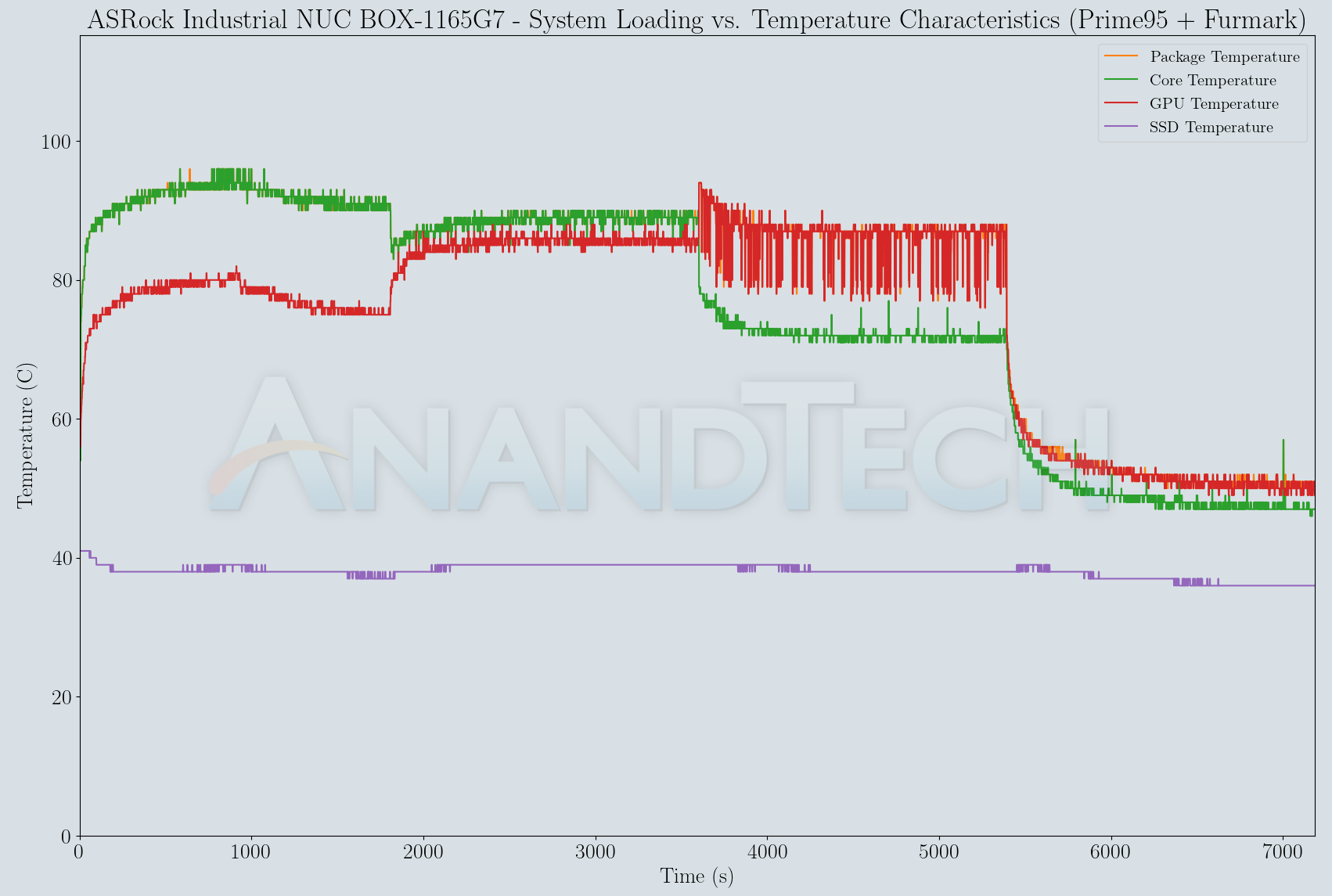ASRock Industrial NUC BOX-1165G7 Mini-PC Review: An Ultra-Compact Tiger Lake Desktop
by Ganesh T S on August 26, 2021 8:15 AM EST- Posted in
- Systems
- Intel
- NUC
- UCFF
- Willow Cove
- ASRock Industrial
- Tiger Lake-U
Power Consumption and Thermal Performance
The power consumption at the wall was measured with a 4K display being driven through the HDMI port. In the graphs below, we compare the idle and load power of the ASRock NUC BOX-1165G7 with other low power PCs evaluated before. For load power consumption, we ran the AIDA64 System Stability Test with various stress components, as well as a combination of Prime95 and Furmark, and noted the maximum sustained power consumption at the wall.

The load power consumption of the NUC BOX-1165G7 actually turned out to be the least of all systems. It doesn't idle as nicely, possibly due to the presence of 64GB of DRAM and the PCIe 4.0 SSD.
Our thermal stress routine starts with the system at idle, followed by four stages of different system loading profiles using the AIDA64 System Stability Test (each of 30 minutes duration). In the first stage, we stress the CPU, caches and RAM. In the second stage, we add the GPU to the above list. In the third stage, we stress the GPU standalone. In the final stage, we stress all the system components (including the disks). Beyond this, we leave the unit idle in order to determine how quickly the various temperatures in the system can come back to normal idling range. The various clocks, temperatures and power consumption numbers for the system during the above routine are presented in the graphs below.
| ASRock NUC BOX-1165G7 System Loading with the AIDA64 System Stability Test | |||

The active cooling solution has no trouble keeping the package temperature below 95C even under extreme stress. The thermal strip over the ADATA XPG GAMMMIX S50 Lite also prevents the SSD from going higher than 70C under extended traffic. The overall air movement ensures that the SSD idles at a sub-40C temperature. On the power front, we see that the package power remains constant at 28W in all scenarios where the CPU is involved. This shows that the thermal solution is good enough to sustain the 28W TDP.
An artificial stress routine using Prime95 and Furmark was also processed. Each workload runs for 60 minutes, with a 30 minute overlap between them. Prime95, configured for maximum power consumption, goes in first, and is followed after 30 minutes by Furmark. The system is then left idle for another 30 minutes. The metrics graphed for the AIDA64 SST case are also graphed for the custom stress test.
| ASRock NUC BOX-1165G7 System Loading with Prime95 and Furmark | |||

The custom stress test also shows that the system is able to sustain 28W package power consumption. The Furmark test is more stressful in terms of GPU power consumption compared to AIDA64's SST GPU workload.
Overall, the NUC BOX-1165G7's thermal solution is good enough for the Tiger Lake-U processor to provide its best possible performance.










33 Comments
View All Comments
sutramassage2 - Wednesday, September 1, 2021 - link
Our flair for showcasing koramangala ingredients shines through in every one of our menus, whether you are looking for a casual lunch or dinner at sutra massage & b2b spa, or a traditional Afternoon sandwich massage. for more info visit here:- https://www.sutramassage.commode_13h - Tuesday, September 21, 2021 - link
spammerwillis936 - Thursday, August 26, 2021 - link
This is a quite nice looking product. I just wish they'd have used a latching power connector.brunosalezze - Thursday, August 26, 2021 - link
I have one of these. Its actually my work pc right now, I dont need a gpu or multiple cores to code, I and have dedicated servers avaiable to run the code. It serves me very well to be able to have 2 4k monitors and not strugle to move the mouse. My only issue with it, its when I try to hook up a gpu with a R43SG. Its very hard to boot, the issue is not the conection, I've used this connector to other mini pcs with my 6800 and always worked very well, the issue is this particular bios, I think.xsoft7 - Thursday, August 26, 2021 - link
there is a Zen3 mini PC.. with 5900HX which costs 649$ can you review it?https://store.minisforum.com/collections/all-produ...
many youtube videos are raving about it.
abufrejoval - Thursday, August 26, 2021 - link
You send them one, they'll be more likely to review it.Now seriously, you can infer quite a bit on Ryzen by looking at what has been tested already.
All these APUs are basically the same silicon operated at distinct power settings, ~15 Watts for 5800U, ~35 Watts for 5900HX and ~65 Watts for 5700G.
The Vega9 graphics don't seem to benefit a terrible lot from extra Wattage, because it's mostly bandwidth constained. There are reviews out there which demonstrate the potential with overclocker DIMMs and an overclocked GPU, but those gains remain linear from a very low baseline.
Peak clocks are just a couple hundred MHz apart, hardly enough to matter, so what you mostly get from the extra Watts is sustained clocks on higher core counts. Go take the values for 15 Watts and 65 Watts, split the difference and add ~20% because CMOS won't give linear clock returns on Watts beyond say 2GHz.
Somewhere on Youtube you'll find someone raving about any thing. But APUs aim really for the very rational, just enough to get the work done in a couple of form factors and at a few price points.
meacupla - Thursday, August 26, 2021 - link
How would a 1135G7 (28W) compare with a Ryzen 5 PRO 5650GE (35W)?There are, or were, plenty of 1L class SFF PCs using the 4650GE, and OEMs are probably transitioning to the 5650GE right now.
If you are going to use a U series APUs at higher TDP, because it's a SFF, I think you might as well include 35W desktop APUs used in SFF for comparison.
abufrejoval - Thursday, August 26, 2021 - link
I got the NUC8 (Iris 655), NUC10 (UHD) and NUC11 (Xe) all as i7, each with 64GB and 10Gbit via Sabrent TB3 (Aquantia really) NICs to operate as a oVirt(RHV) HCI cluster.Played around with Windows a bit before they became "productive".
I was really interested to see how the iGPU generations would play out and in IPC vs cores, 14nm vs. 10nm etc.
Twice the iGPU resources (48 vs 24EU) + the 128MB eDRAM on the Iris 655 only got 50% performance increase, just as the 3DMark gaming score shows. That seemed to spell trouble for the 96EU Xe, which doesn't have any of that. But it didn't. Instead the 96EU Xe scales pretty much linearly vs the 24EU UHD, but that still doesn't make it a games engine. Still a NIght Raid or WildLife type game runs just fine at FHD on the NUC11.
In terms of CPU benchmarks, it was a clear win for the NUC11. It got awfully close to my 5800X on single core benchmarks, especially on Linux, while the 6-Core 10700U could not gain ground against the 4-Core 1065G7 on e.g. Blender or anything thready.
I also have a Lenovo 5800U notebook, which can be configured for the 28Watt and 15Watt energy consumption levels (which is sticks to, religiously!) and it really can't gain much ground on thready workloads against the 1065G7, either, when that is configured to those same 15 and 28 Watt limits. I only measured via HWinfo, not at the wall, so there is that.
What I really like about the NUCs is that they allow very precise control over P1, P2, TAU and the fans (I need absolute control over maximum noise and want max CPU for that in operation). They give you that, while the generation over generation looks of that BIOS are so different, it seams to be completely different teams.
Ah and yeah, the Xe graphics do outperform the Vega9 on the 5800U significantly in numbers, while it doesn't really matter for gaming. Both are super smooth with Google Maps in 3D mode on Chromium in Windows at 4k. But any software less optimized will struggle beyond 2D.
Multi-Monitor support on all the Intel iGPUs is excellent on Windows and Linux, the Vega9 has serious issues switching between external and internal graphics even on Windows. A dual alt-mode USB-C adapter which supports a 4k primary and a FHD secondary seamlessly on any Intel iGPU with very OS I've tested works as you'd expect it, but with the Radeon drivers (both Lenovo and latest AMD) just switching between the 3k laptop screen and the external 4k primary freezes the output to the point where only a hard poweroff will bring it back.
With all systems playing with the power settings (15-64Watts for the NUCs, 12-28Watts for 5800U), those settings did little to nothing for the iGPU. It's really just all about how much left-over budget goes to enable higher CPU clocks (until thermals kick in).
zsdersw - Friday, August 27, 2021 - link
What exactly is "industrial" about it? If it's not fanless it can't really be considered industrial and it's just another NUC-type computer.abufrejoval - Friday, August 27, 2021 - link
The marketing channel.They don't metion any testing specification in the technical data on the ASrock web site.
Without that it may just mean that consumer (fool protection) return rights might not apply.